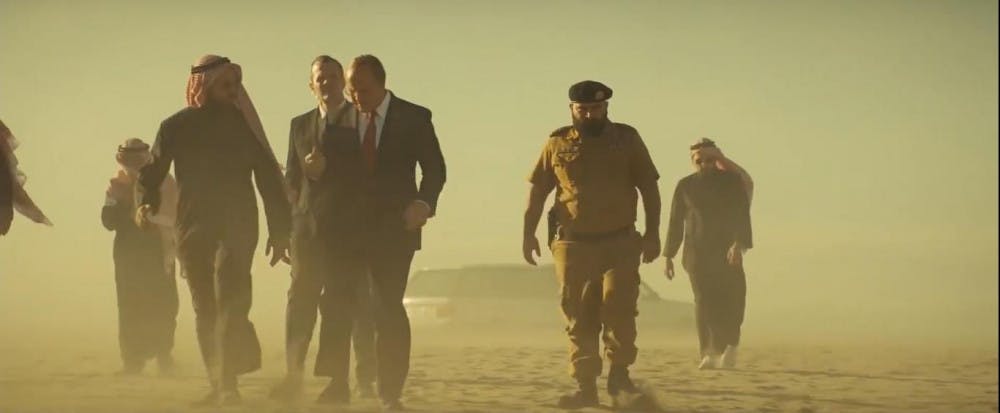by Daniel O'Connell
Adam McKay has proven himself to be one of the most influential writers of American comedies in the 21st Century. Since starting off on Saturday Night Live, he has written and directed such hit comedies as Step Brothers, Talledega Nights: The Ballad of Ricky Bobby, The Other Guys, and the internet’s favorite: Anchorman: The Legend of Ron Burgundy. However, in 2015 he proved he could do serious by directing The Big Short, a dark comedy about the financial crisis of the late 2000s. This earned him an Academy Award for Best Adapted Screenplay. Now McKay delivers another serious film with Vice, concerning the history of former Vice President Dick Cheney.
Excellent acting from a brilliant cast

What’s tricky about doing a biopic about an important political figure like Dick Cheney is portraying him properly. If the portrayal was done poorly the entire film would come across like a bad, feature length Saturday Night Live sketch. Fortunately though, the casting and performances that are amazing all around. The biggest standout in the cast is Christian Bale portraying Cheney himself. Similarly to his roles in films such as The Machinist or American Hustle, Bale completely transforms himself into the role to the point where he almost becomes unrecognizable. Bale’s performance easily makes the movie worth the ticket price.
The other members of the cast are just as strong. Amy Adams does a great job of portraying Dick’s wife Lynne Cheney, especially early in the two’s relationship. The always-excellent Sam Rockwell nails his role as George W. Bush, incorporating Bush’s speaking patterns, mannerisms, and even facial expressions. The only real weak link of the cast is Steve Carrell as Donald Rumsfeld. It’s not that Carrell does an overall bad job in the role, but his performance is hit or miss. He works best when portraying an older Rumsfeld in the 2000s; however, when the film is in the 1970s-1980s it comes across as Carrell playing a jerkier version of Michael Scott.
Unique, interesting presentation
Despite being marketed as a dark comedy like The Big Short, Vice is mostly played as a straightforward biopic with comedic elements here or there. However, like The Big Short, it has a very unique way of presenting itself, and that alone makes it an interesting watch. The film opens with text stating that the film is a true story, or as true as one can get when talking about a man as secretive as Dick Cheney. The text concludes by saying that the filmmakers “tried their f*cking best.”
The majority of the film is narrated by an Iraq War veteran (played by Jesse Plemons) who stops to explain unfamiliar concepts like the unitary executive theory to the audience. The film also alternates to a news anchor played by Naomi Watts to provide additional exposition. This is similar to what McKay did in The Big Short where he would cut to Margot Robbie in a bubble bath or the late Anthony Bourdain cutting up a fish in order to explain complex economic subjects to the audience.

The strong presentation choices do not end there. There are other scenes that have a unique way of showing how Cheney conducted his term as Vice President. One scene with Cheney assuming power shows the various government agents as pieces on a game board with agents rolling the dice. In another, Cheney’s options on how to conduct the War on Terror are shown as him having dinner at a restaurant, where a waiter (played by Alfred Molina) presents each of his options as if they were items on a menu. However, the humor of these presentations really shines when Lynne goes off on a Shakespearean monologue about taking over the world on the night before Cheney becomes the Vice President, right after the narration says that they have no idea what the couple said before this fateful night. Another humorous moment comes in the middle of the film, when the filmmakers pretend that the movie is over with the Cheney’s working in the private sector and avoiding politics. Fake ending credits appear before a phone call interrupts them, in which Bush gives Cheney the offer to become his running mate.
However, while most of these unique forms of presentation work in the film’s favor, others do not. The film makes use of montages in the decades the film takes place in. This includes the infamous Budweiser “Whassup?” commercial being juxtaposed against imagery of the Abu Gharib prison scandal. These montages can take one out of the movie, and by the end, start to drag. Another thing that the film does is briefly skim through events after it reaches the invasion of Iraq. The film should’ve taken more time to expand on certain events after this point, and many little tidbits they did include end up feeling tacked on as a result.
Images: IMDb
Featured Image: IMDb




















